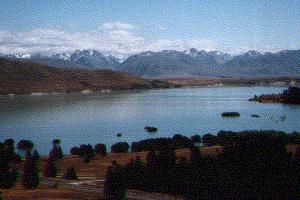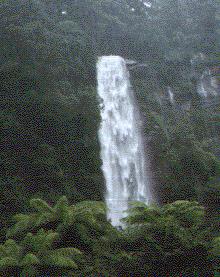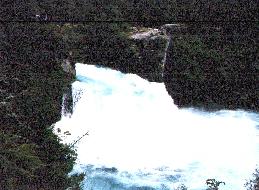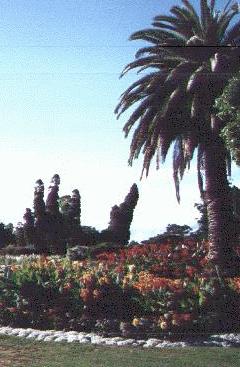
I never thought about visiting New Zealand, but a few years ago I was
invited to visit my relatives in New Zealand.
At first I thought it was a crazy idea, but thinking it over it seemed
to be possible. Well, to make a long story short, I visited New Zealand
together with my brother.
You will see some impressions of New Zealand on this page.

 After a long flight from Los Angeles I arrived with my brother in Auckland on the
23 rd of January 1995 at seven o'clock in the morning.
We took the domestic flight to Christchurch where we collected our
rental car. This car was a Suzuki Swift, a fine car to drive.
After receiving some information about New Zealand at the tourist office,
we looked around in Christchurch, and then we started to drive over the large
plains to the Southern Alpes.
On the picture you can see the Alpes, with one
of the many lakes in front of it.
It was a dry summer in New Zealand, as you can see on the photo.
After a long flight from Los Angeles I arrived with my brother in Auckland on the
23 rd of January 1995 at seven o'clock in the morning.
We took the domestic flight to Christchurch where we collected our
rental car. This car was a Suzuki Swift, a fine car to drive.
After receiving some information about New Zealand at the tourist office,
we looked around in Christchurch, and then we started to drive over the large
plains to the Southern Alpes.
On the picture you can see the Alpes, with one
of the many lakes in front of it.
It was a dry summer in New Zealand, as you can see on the photo.

The Southern Alpes are not very wide, you can cross them in a few hours
with a car.
On the other side the vegetation is totally different, as the next pictures
will show.
They call it rainforest, and now I now why. The mountains on the west
coast of the South Island act as a barrier for the clouds coming from
the Tasman sea. The result is a lot of rain on the westcoast.
Even for the local people, there was a
lot of rain falling when we arrived on the west cost. As we were camping,
we were lucky and we had one dry night and a dry morning, but in
the afternoon of the following day it started
to rain again. This photo is taken on de day we arrived on the westcoast,
and it was raining very hard. You can see the droplets coming down as
faint stripes.
The glazier on the next picture is the Frans Jozef glazier, one of the two glaciers on the westcoast. Because it had rained so much, the glazier was difficult to reach. We had to pass some icy streams, with the ice from the glacier in it. The best thing to do was to pass the streams barefooted, to keep our shoes dry. A cold option! The glacier itself was dangerous, with big pieces of ice coming off. During our stay near the glacier many tonnes of ice came down into the river. The result of this was that the river changed its flow, an don our way back we had to pass the fast flowing streams with more water and ice in it. It was easy to get hurt, as some of the pieces of ice were several kilo's heavy. And we didn't escape uninjured, we suffered several bruises on our legs. When we returned to our car it started to rain again. We then decided to go back to the east side of the Island, hoping for some dry weather. And we were lucky, after passing Arthurs Pass the rain stopped, and the next days were dry. |
 We took the ferry from Picton to Wellington early in the morning and during
the day we drove to the north, to the centre of the North Island.
On our trip to the north we visited this blue waterfall.
We took the ferry from Picton to Wellington early in the morning and during
the day we drove to the north, to the centre of the North Island.
On our trip to the north we visited this blue waterfall.

Rotorua is famous for it hot springs. We visited several of them, but
in the evening of our stay near Rotorua we visited the Government Gardens in
the town (the picture on the left).
These gardens are very nice with a lot of colourful flowers.
You would not believe it, but the next picture on the right is just a
park in Whangarei. A small
stream is flowing through the park, with a real waterfall in it. Whangarei
is the most northerly city of New Zealand. We stayed there for some days,
and made some trips in Northland, as this part of New Zealand is called.
The next picture shows a tree. It is not a normal tree, as you can see on the picture. This tree, the Kauri, is the largest tree of the world after the North American Sequia. One tree in this forest is more then 2000 years old. There are only a few forests left with these trees on the North Island.
And now some history. The house on the last photo is the Treaty House.
It is one of the oldest buildings in New Zealand. The house is located in the
Waitangi national reserve.
In 1840 the Treaty of Waintangi was signed here.
|
